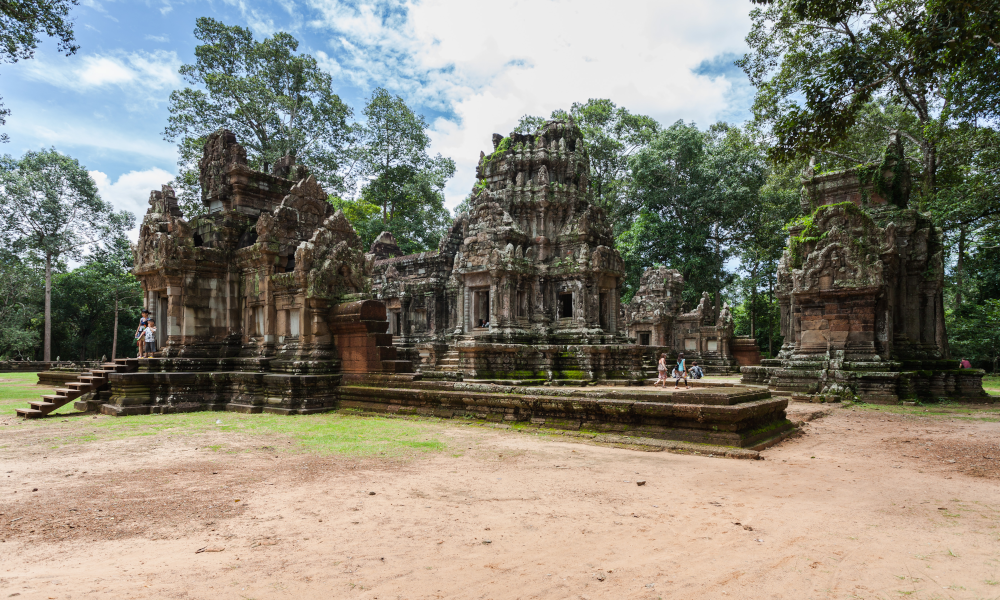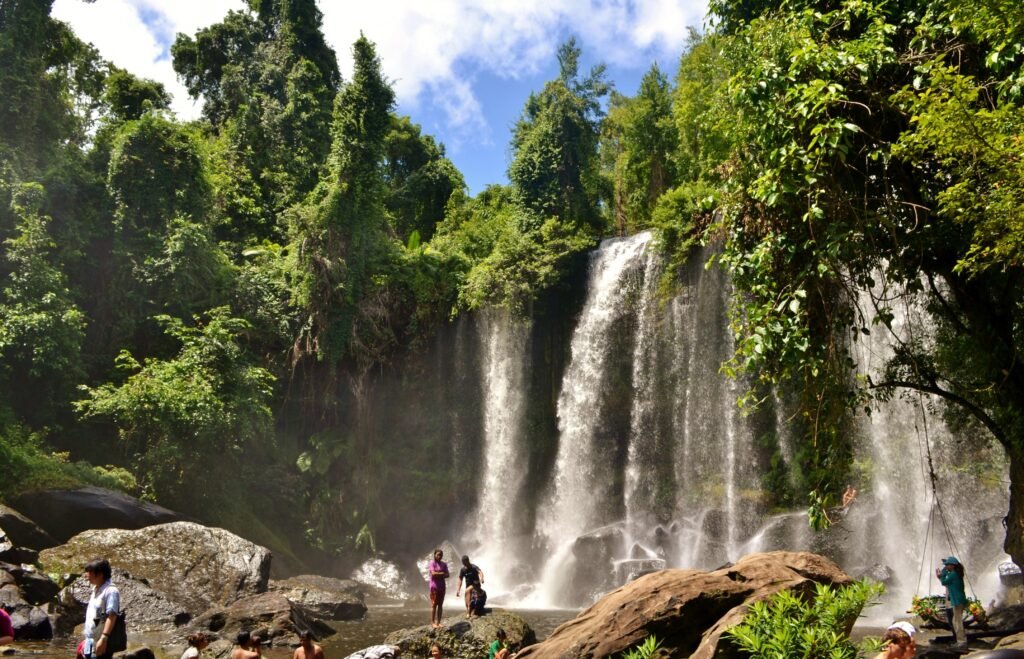Chau Say Tevoda Temple

Chau Say Tevoda is a temple situated within the Angkor Archaeological Park in Siem Reap, Cambodia. It is positioned just to the east of Angkor Thom, before the Victory Gate, and directly across from Thommanon Temple.
This temple is frequently overlooked during temple tours, which is unfortunate, as it represents a remarkable example of artistry. Visitors can appreciate numerous architectural elements and decorative arts that reflect the zenith of the ancient Khmer Empire in a more compact setting, all within a tranquil environment.
Upon entering from the east, notable features of the site include the bollarded entrance, the expansive elevated cruciform terrace, and the raised causeway supported by round columns, which once showcased a naga balustrade. The outer enclosure is marked by entry gopura (gates) at each cardinal direction, along with two “library” structures, a central shrine with a mandapa (hall), bas reliefs of devata embellishing the walls, intricately carved pediments, and elaborate decorations throughout the site.
There is no inscribed record indicating the temple’s foundation, but scholars estimate its construction to have occurred between the 11th and 12th centuries, with a likelihood of it being in the 12th century. The architecture is characteristic of the Angkor Wat style, and it is believed to have been dedicated to the deities Shiva and Vishnu. Additionally, the site contains Buddhist imagery, which may have been added later and could have experienced damage during the iconoclastic period following the reign of Jayavarman VII (1181–1218 AD).
Experience an exclusive tour of Kulen Mountain, Beng Mealea, and Tonle Sap Lake, including transportation from Siem Reap. Discover the Reclining Buddha and the 1000...
Layout and Design
The temple is encircled by an outer wall that includes four gopuras positioned at each cardinal direction, with the principal entrance oriented towards the east. This entrance leads to a raised walkway measuring 25 meters in length, which connects to a large cruciform terrace adorned with a naga balustrade, remnants of which remain in situ. Further to the east, this pathway transitions into a bollarded entryway that meets the present-day Siem Reap river.
At the heart of the temple stands a singular central shrine, characterized by a tower and an eastward-extending mandapa (hall). This structure is linked to the eastern entry gopura by a short elevated terrace.
Flanking the central tower are auxiliary structures commonly identified as libraries. The site is richly embellished, showcasing intricate floral wall patterns, roundels, devata reliefs, and lintels—some of which are missing, damaged, or have been restored—along with elaborate pediments that illustrate both Hindu and Buddhist themes.
The longer one spends at this site, the more the intricate artwork unveils itself. It is a remarkably ornate location, representing the zenith of ancient Khmer artistry.
History & Restoration of Chau Say Tevoda
The temple underwent a clearing process in the mid-1920s, conducted by Henri Marchal, followed by restoration through anastylosis in the 1950s. During this period, numerous artifacts were unearthed, including a remarkable statue of Nandin, the sacred bull, various Mahayana-era Buddhist sculptures, and additional items. Black and white images are owned by EFEO, with more available for viewing at Fonds Cambodge.
In more recent developments, archaeological research was initiated in 1998 and concluded in 2009, undertaken by APSARA and UNESCO in collaboration with the Chinese Cultural Relics Research Institute. This research uncovered a diverse collection of both glazed and unglazed pottery, jars, and Chinaware, all dating back to the Song and Yuan Dynasties. The excavations also revealed rammed earth roads connecting the four entrances of the temple, suggesting that the raised terrace at the eastern entrance, as well as the one linking the central shrine to the eastern gopura, were constructed subsequent to the temple’s original building.
Why Visit Chau Say Tevoda?
The temple was previously in a dilapidated condition, with approximately 4,000 fragments scattered throughout the vicinity. Nevertheless, the Chinese initiated a nine-year restoration endeavor, transforming it into a remarkable destination for visitors.
Many tourists tend to disregard this temple, opting instead for more renowned sites such as Bayon or Ta Prohm. As a result, visitors can enjoy a tranquil exploration of the area.
This allows for excellent photographic opportunities of this Angkor Wat-style temple, free from the obstruction of large crowds.
Location & How to Get There
Other Temples
-
Ak Yum Temple
-
Tep Pranam Temple
-
Khleangs Temple
-
Spean Thma
-
Prasat Suor Prat
-
Preah Pithu Group
-
Preah Palilay
-
Terrace of the Leper King
-
Terrace of the Elephants
-
Phimeanakas Temple
-
Banteay Prei Temple
-
Banteay Srei Temple
-
Prasat Kravan Temple
-
Ta Keo Temple
-
Chau Say Tevoda Temple
-
Thommanon Temple
-
Pre Rup Temple
-
East Mebon Temple
-
Ta Som Temple
-
Neak Pean Temple
-
Phnom Bakheng
-
Phnom Krom Mountain
-
Preah Khan Temple
-
Roluos Group
-
Banteay Kdei Temple
-
Baphuon Temple
-
Banteay Samre Temples
-
Beng Mealea Temple
-
Ta Prohm Temple
-
Bayon Temple
-
Angkor Thom Temple
-
Angkor Wat Temple
Experiences in Siem Reap
-
Cambodia Visa Requirements: All thing you need to know
-
Cambodia SIM Card: How to buy and price details
-
Money Exchange in Cambodia: What travelers need to know?
-
Useful Contacts For Travelers In Cambodia
-
Tourist Info Center: When Travel in Cambodia
-
Angkor Archeological Park
-
Suggested Siem Reap Itineraries
-
Reasons Against Financial Assistance to Begging Children
-
Pub Street
-
Siem Reap’s Local Markets
Cambodia Guide
-
Preah Vihear Province
-
Tonel Sap
-
Siem Reap Province
-
Cambodia Seasons
-
Mekong River
-
Battambang Province
-
Kampot
-
Sihanouk Ville
-
Phnom Penh: The campital city of Cambodia
-
National Religion of Cambodia - Buddhism
-
The History of Cambodia
-
Introduction to Cambodia
-
Public Holidays in Cambodia
-
Best Time to Visit Cambodia

